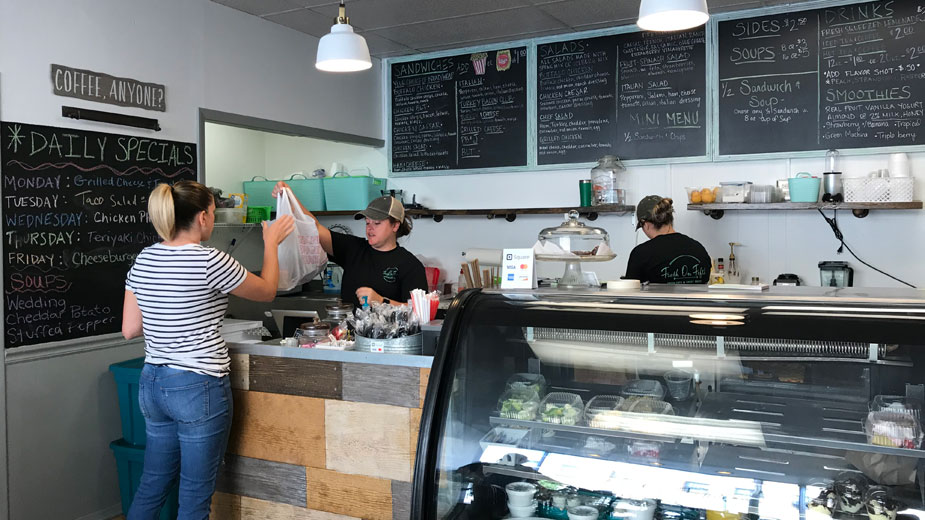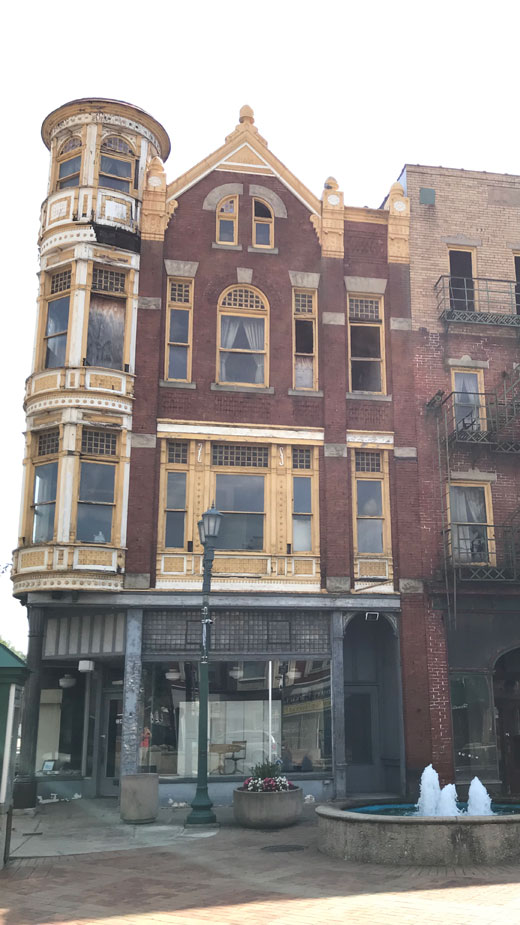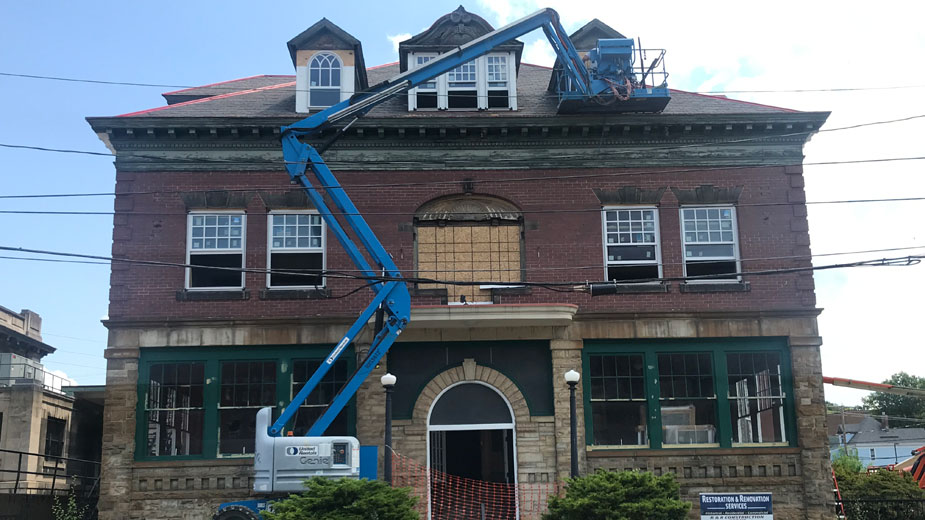East Liverpool Pools Its Development Resources
EAST LIVERPOOL, Ohio – After years in a slumping economy, the city of East Liverpool is starting to revive because of a collaborative effort among many people.
So says Mayor Ryan Stovall, completing his first term and seeking a second. Recovery is well underway thanks to “the teamwork that takes place between all departments and branches of our city government. Make no mistake, though, the progress is just beginning,” he said in his recent state of the city address.
Stovall credits his administration, City Council, the housing and planning departments, the city’s community improvement corporation, the county land bank committee and the East Liverpool Community Partnership for Revitalization for their efforts in promoting economic development.
In addition to the $7 million transformation of two abandoned downtown buildings into the New Castle School of Trades and the $14 million new construction of the Market Street Lofts, which began before Stovall’s election, he says the city made “that critical turnaround that needed to happen to help foster growth and development” in 2018 when his administration enticed FarmaceuticalRX, a medical marijuana business, to the city.
“FRX Health came to East Liverpool not knowing what to expect but quickly realized that this would be their Ohio home as we welcomed them with open arms,” Stovall says.
In addition to the medical-marijuana dispensary it opened in the city, the company is in the process of renovating the former Ferro Corp. manufacturing building into a building for cultivation and processing of medical marijuana.
It is estimated that FRX could realize as much as $100 million in profits once fully operational, which Stovall says would generate an additional $1.5 million in city tax revenue.
Rebecca Myers, CEO of FarmaceuticalRX, said recently an additional $20 million has been raised to get the cultivation and processing business started at the former Ferro building on Harvey Avenue. She said an additional 50 people were hired at the company’s Farrell, Pa., site, with another 20 to 30 expected to be hired there within six months.
“So, our projections for jobs starting at $15 an hour will be accurate for our Ohio facility as well,” Myers said.
A new Dollar General was also built downtown this year, opening in the spring and replacing a smaller store, with additional employees hired, which Stovall says also added to the tax base.
Announced just recently was the planned construction of a new post office in the downtown historic district to replace the existing site.
“When someone moves to a city, there are three things they always ask: Where is the grocery store? Where is the pharmacy? And where is the post office?” Stovall says. The developer chosen by the U.S. Postal Service for the project will construct the new building on the Buckeye Online School for Success parking lot at Walnut and Fifth streets.
The building currently leased by the USPS needs some repair work, which prompted the move, he says.
A 15-year property tax abatement is being proposed for the project, which would have to also be approved by the city school district, since it would receive the bulk of the property taxes.
The city receives no tax revenue from that parking lot because a school owns it, so tax abatement for the new construction won’t mean a loss in revenue, Stovall points out.
“We’re not losing anything and get to keep the post office in the city,” says Stovall. Otherwise, there is a chance the postal service could relocate to adjacent St. Clair Township.
Meanwhile, Stovall says his administration will work with the owner of the post office building to find another use for it.
Another project underway that officials say will enhance the downtown area is the remodeling of the Masonic Temple on Broadway Street, where the exterior has received all new windows and trim in keeping with the historic architecture of the building and the downtown historic district.
While there are still many empty storefronts in the downtown, some have opened or are preparing to open, and other plans are in the works for turning the historic downtown into a focal point.
One of those that has been open just two years is Fresh on Fifth, a restaurant on Fifth Street owned by cousins Mandy O’Brien and Kiley May, who were born and reared in East Liverpool.
“We always dreamed of opening a business,” O’Brien says, “and it made sense to do it here.”
The partners were two of many business owners who took advantage of the CIC revolving-loan fund for small businesses and decided to rent the storefront owned by a family friend for their venture.

“It’s going fantastic,” O’Brien said during a break in the lunch-hour traffic. Customers can choose from a large menu of homemade dishes, many of which are made from the cousins’ grandmother’s recipes.
“We wanted fast-food but fresh. We use only premium ingredients and offer good, healthy options. We don’t buy pre-made things,” O’Brien says.
She says the entire process of opening the business has been “great. I can’t say one bad thing about the city. It has been more than open with us.”
In fact, O’Brien says they would like to have more space to expand the business and Stovall has offered to help them see what is available in the city.
“We would love to have more dining area and event space, but right now there’s nothing readily available with commercial-kitchen space,” according to O’Brien, who expressed some reluctance at footing the tens of thousands of dollars needed to install such a kitchen in a rented space.
O’Brien says she is “really excited” about a coffee shop set to open up directly across the street. “It’s nice to see other things opening. I’m a firm believer that you need to have other businesses like yours around. People eat three times a day. It’s nice to have a variety of options.”
She says they hope to continue expanding and to keep their business in the city. “Our hearts are in East Liverpool, and we’d love to see it thrive again.”
There are those business owners who saw East Liverpool during its heyday and then at its economic worst, yet still have a desire to stay.
One of those is Craig Kidd, owner and sole employee of Keystone Printing, which was founded in 1921 by his great-grandfather, Charles Kidd, who immigrated from Scotland.
After starting a print shop in the alley behind Central Fire Station, the elder Kidd had the current building constructed for his printing business in 1923.
His great-grandson graduated from East Liverpool High School on a Friday in 1978 and on the following Monday started his career in the print shop that continues today.
“I’ve been around it all my life,” Kidd says.
With the advent of electronic media and the ability of consumers to buy printed materials quickly online, Kidd says he has nonetheless been able to stay competitive.
“I found a niche of sorts, running color work that a lot of bigger companies won’t touch. My business relies on other businesses, not people walking in off the street. Within the past 10 to 15 years, I’ve been seeing new businesses established. I’m very fortunate with the customer base I have,” Kidd says.
While some critics say the city is not business-friendly, Kidd disagrees. “There is a renaissance occurring in East Liverpool. Young minds have stepped up to the plate and have great ideas for [the city]. I like how ELCPR is focusing on the Diamond as people-centric as you see in Beaver (Pennsylvania). That’s what we’re lacking here.”
The East Liverpool Community Partnership for Revitalization, composed of community leaders, city administrators, City Council and members of the school board, has been active for four years. President Drew Cooper says its goal is to promote the renewal of East Liverpool with a focus on stirring up the downtown, which is seen as the core that can make the area great.
“We’re just the glue to bring all the different facets together toward a common vision and plan to renew the city, specifically downtown,” Cooper says. “We are out to prove downtowns are what make all great cities great.”
Through trial and error, the ELCPR has sponsored pop-up concepts and projects, such as the popular jazz and barbecue festival, in the downtown area.
According to Cooper, “Where cars and people are, that’s where you want your business.”
Pointing out ELCPR was the glue that brought together the New Castle School of Trades project, Cooper says that is a prime example of what can be accomplished by working together.
The partnership is currently working on key strategies and initiatives, partnering with city native Thomas Chema, a consultant with The Gateway Group and with Kent State University.
The 2034 Vision, Strategy & Implementation Plan will be put in motion over the next 15 years, culminating with the city’s 200th anniversary. The theme of the first phase is “The Point of New Beginning.”
Ultimately, plans call for the downtown to be a hub of cultural activity with dining, shopping, museums, a river walk and bike trail, performance center, recreation center and more.
Cooper says the first phase will focus on getting the community engaged through cleanliness and beautification projects, such as sprucing up empty storefronts, cleaning streets and installing uniform signage.
“Our rule is, ‘You can’t cover everything.’ We’ll get more impact by restoring the historic Devon’s Diamond. We’ve proven by our festival that it creates a great gathering place. What we’ve lost is great people-centered spaces. We need to make it a great place to live. That starts with making a great downtown,” Cooper explains.
A website is being prepared that will be used to engage the community and solicit suggestions.
Improving the city will entail improving and using many of the now-vacant historic and newer buildings, and city officials are taking steps to move in that direction.
Planning director Kayla Crowl refers to discussions taking place among city council, headed by councilman John Mercer, about improving the appearance of empty storefronts by enacting legislation requiring them to be filled, not just papered over.
The CIC has recently obtained ownership of the Thompson Building, a cornerstone of Devon’s Diamond. “The ultimate goal is to find a developer and at least preserve the front facade, following the historic guidelines,” Crowl says.
Appropriate window coverings and roof coverings are being readied for the Thompson Building, with plans to use a drone to assess the condition of the roof.

Meanwhile, the city planning department is reviewing an inventory of those buildings to determine who is willing to sell, buy or lease them.
Crowl says the historic buildings, which dominate the downtown, have been a cornerstone for the city. “That’s what we want to keep. We want that booming down there again.”
But the downtown area is not the sole focus of city officials. Plans are being discussed for some properties along Erie Street that could be transferred from the land bank committee to the CIC, as was the Thompson Building, opening the property up for development. The CIC makes available the small-business loans that have helped many city business owners, according to Crowl.
The location of the Shell cracker plant upriver in nearby Monaca, Pa., and another proposed for downriver in Belmont County also have the potential of improving the city’s economy, Mayor Stovall points out.
Already, one business has relocated its operations from Boardman to the East End of the city to take advantage of the proximity to the plant in Monaca. “He would never have relocated here otherwise,” Stovall says.
With thousands working on the construction of the plant, East Liverpool offers a less expensive housing alternative than either Pennsylvania or West Virginia, the mayor adds.
“West Virginia has personal property tax and Pennsylvania’s taxes are terrible. Our location is perfect. If you can live somewhere cheaper only 15 to 20 minutes from your job, it makes perfect sense to do that.”
Pictured: Remodeling work on the Masonic Temple in downtown East Liverpool lends itself to the city’s economic development efforts, according to business leaders.
Copyright 2024 The Business Journal, Youngstown, Ohio.



